2006 CHEVROLET EXPRESS PASSANGER instrument panel
[x] Cancel search: instrument panelPage 1 of 406

Seats and Restraint Systems........................... 1-1
Front Seats
............................................... 1-3
Rear Seats
............................................... 1-7
Safety Belts
.............................................1-10
Child Restraints
.......................................1-31
Airbag System
.........................................1-66
Restraint System Check
............................1-83
Features and Controls..................................... 2-1
Keys
........................................................ 2-2
Doors and Locks
....................................... 2-7
Windows
.................................................2-14
Theft-Deterrent Systems
............................2-17
Starting and Operating Your Vehicle
...........2-18
Mirrors
....................................................2-29
Storage Areas
.........................................2-34
Instrument Panel............................................. 3-1
Instrument Panel Overview
.......................... 3-4
Climate Controls
......................................3-18
Warning Lights, Gages, and Indicators
........3-23
Audio System(s)
.......................................3-44
Driving Your Vehicle....................................... 4-1
Your Driving, the Road, and Your Vehicle
..... 4-2
Towing
...................................................4-35Service and Appearance Care.......................... 5-1
Service
..................................................... 5-3
Fuel
......................................................... 5-5
Checking Things Under the Hood
...............5-10
All-Wheel Drive
........................................5-43
Rear Axle
...............................................5-44
Front Axle
...............................................5-44
Noise Control System
...............................5-45
Bulb Replacement
....................................5-46
Windshield Wiper Blade Replacement
.........5-52
Tires
......................................................5-53
Appearance Care
.....................................5-84
Vehicle Identification
.................................5-93
Electrical System
......................................5-94
Capacities and Specifications
.....................5-99
Maintenance Schedule..................................... 6-1
Maintenance Schedule
................................ 6-2
Customer Assistance and Information.............. 7-1
Customer Assistance and Information
........... 7-2
Reporting Safety Defects
...........................7-15
Index................................................................ 1
2006 Chevrolet Express Owner ManualM
Page 4 of 406
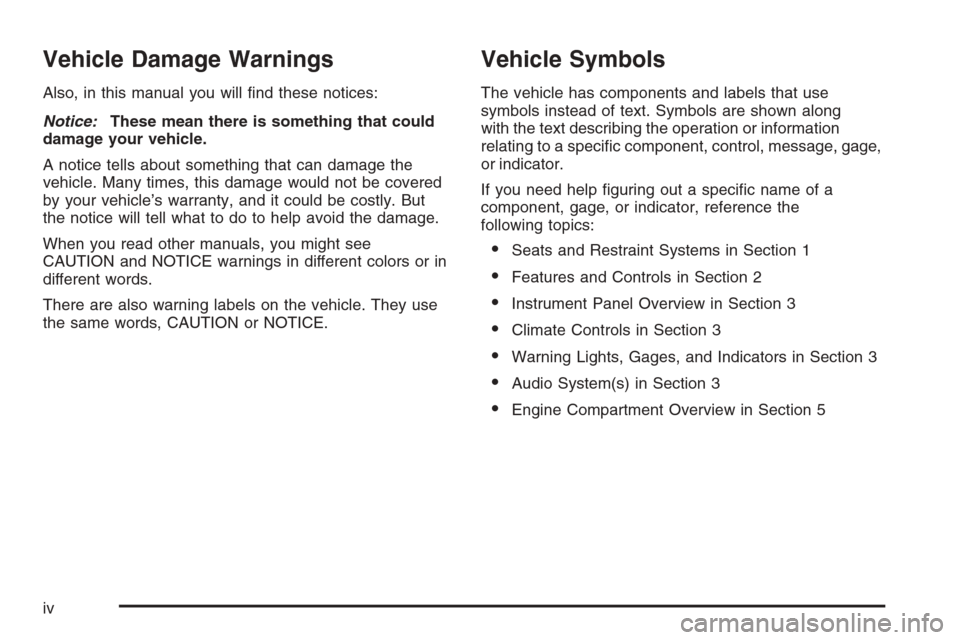
Vehicle Damage Warnings
Also, in this manual you will find these notices:
Notice:These mean there is something that could
damage your vehicle.
A notice tells about something that can damage the
vehicle. Many times, this damage would not be covered
by your vehicle’s warranty, and it could be costly. But
the notice will tell what to do to help avoid the damage.
When you read other manuals, you might see
CAUTION and NOTICE warnings in different colors or in
different words.
There are also warning labels on the vehicle. They use
the same words, CAUTION or NOTICE.
Vehicle Symbols
The vehicle has components and labels that use
symbols instead of text. Symbols are shown along
with the text describing the operation or information
relating to a specific component, control, message, gage,
or indicator.
If you need help figuring out a specific name of a
component, gage, or indicator, reference the
following topics:
•Seats and Restraint Systems in Section 1
•Features and Controls in Section 2
•Instrument Panel Overview in Section 3
•Climate Controls in Section 3
•Warning Lights, Gages, and Indicators in Section 3
•Audio System(s) in Section 3
•Engine Compartment Overview in Section 5
iv
Page 20 of 406
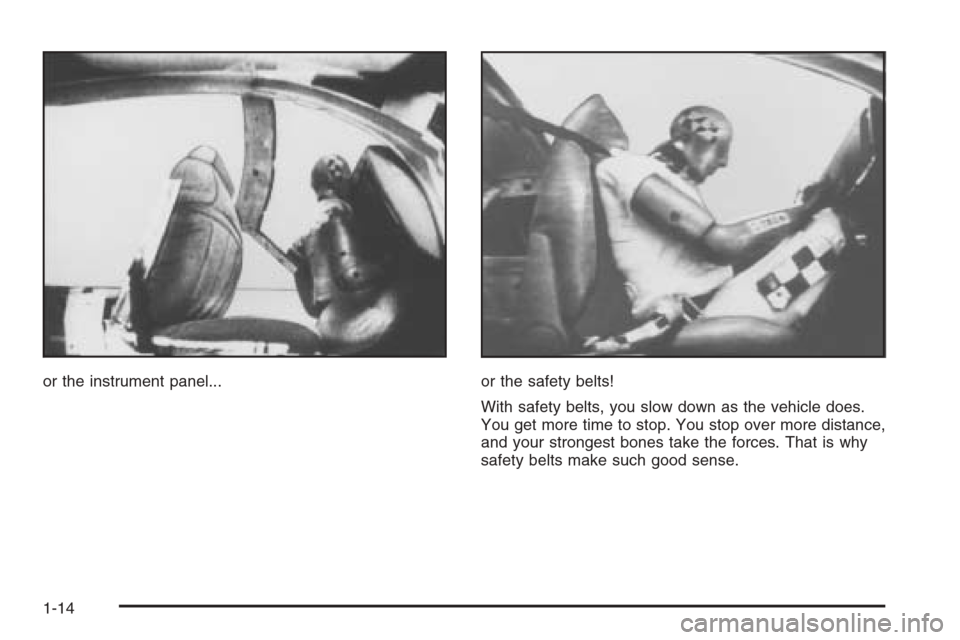
or the instrument panel... or the safety belts!
With safety belts, you slow down as the vehicle does.
You get more time to stop. You stop over more distance,
and your strongest bones take the forces. That is why
safety belts make such good sense.
1-14
Page 66 of 406

7. If your child restraint manufacturer recommends
using a top tether and the position you are using
has a top tether anchor, attach and tighten the
top tether to the top tether anchor. Refer to the
instructions that came with the child restraint and to
Lower Anchors and Tethers for Children (LATCH) on
page 1-43.
8. Push and pull the child restraint in different
directions to be sure it is secure.
9. If the airbag is off, the off indicator on the instrument
panel will be lit and stay lit when the key is turned
to RUN or START.
If a child restraint has been installed and the on
indicator is lit, turn the vehicle off. Remove the child
restraint from the vehicle and reinstall the child restraint.
If after reinstalling the child restraint and restarting the
vehicle, the on indicator is still lit, check to make sure
that the vehicle’s seatback is not pressing the child
restraint into the seat cushion. If this happens, slightly
recline the vehicle’s seatback and adjust the seat
cushion if possible. Also make sure the child restraint is
not trapped under the vehicle head restraint. If this
happens, adjust the head restraint.If the on indicator is still lit, secure the child in the child
restraint in a rear seat position in the vehicle and
check with your dealer.
To remove the child restraint, if the top tether is attached
to the top tether anchor, disconnect it. Unbuckle the
vehicle’s safety belt and let it go back all the way.
The safety belt will move freely again and be ready to
work for an adult or larger child passenger.
Securing a Child Restraint in
the Right Front Seat Position
(With Airbag Off Switch)
Your vehicle has a right front passenger airbag. There
is a switch on the instrument panel that you can use
to turn off the right front passenger’s frontal airbag.
SeeAirbag Off Switch on page 1-73for more on this,
including important safety information.
1-60
Page 68 of 406
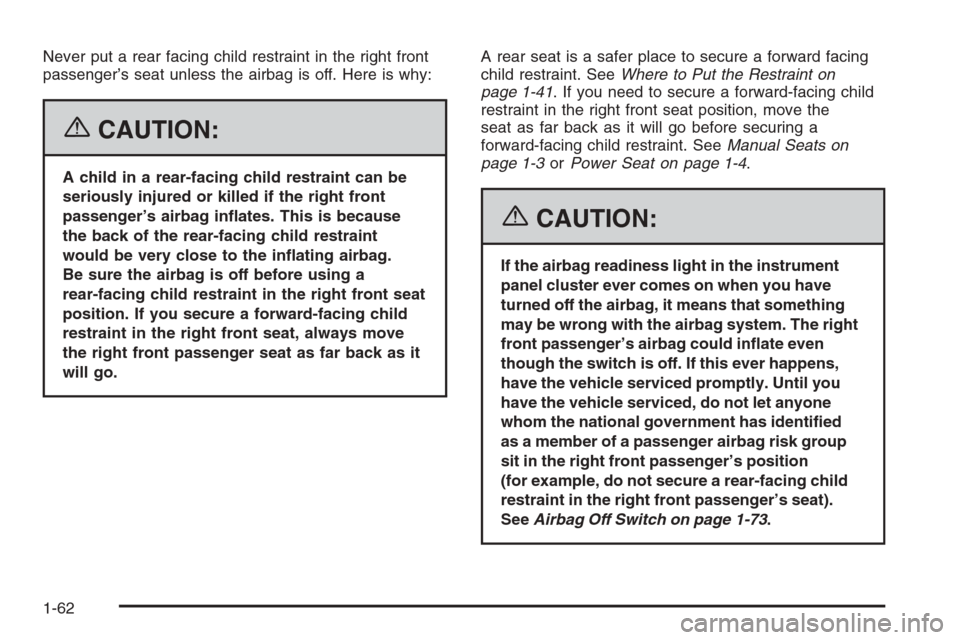
Never put a rear facing child restraint in the right front
passenger’s seat unless the airbag is off. Here is why:
{CAUTION:
A child in a rear-facing child restraint can be
seriously injured or killed if the right front
passenger’s airbag in�ates. This is because
the back of the rear-facing child restraint
would be very close to the in�ating airbag.
Be sure the airbag is off before using a
rear-facing child restraint in the right front seat
position. If you secure a forward-facing child
restraint in the right front seat, always move
the right front passenger seat as far back as it
will go.A rear seat is a safer place to secure a forward facing
child restraint. SeeWhere to Put the Restraint on
page 1-41. If you need to secure a forward-facing child
restraint in the right front seat position, move the
seat as far back as it will go before securing a
forward-facing child restraint. SeeManual Seats on
page 1-3orPower Seat on page 1-4.
{CAUTION:
If the airbag readiness light in the instrument
panel cluster ever comes on when you have
turned off the airbag, it means that something
may be wrong with the airbag system. The right
front passenger’s airbag could in�ate even
though the switch is off. If this ever happens,
have the vehicle serviced promptly. Until you
have the vehicle serviced, do not let anyone
whom the national government has identi�ed
as a member of a passenger airbag risk group
sit in the right front passenger’s position
(for example, do not secure a rear-facing child
restraint in the right front passenger’s seat).
SeeAirbag Off Switch on page 1-73.
1-62
Page 72 of 406
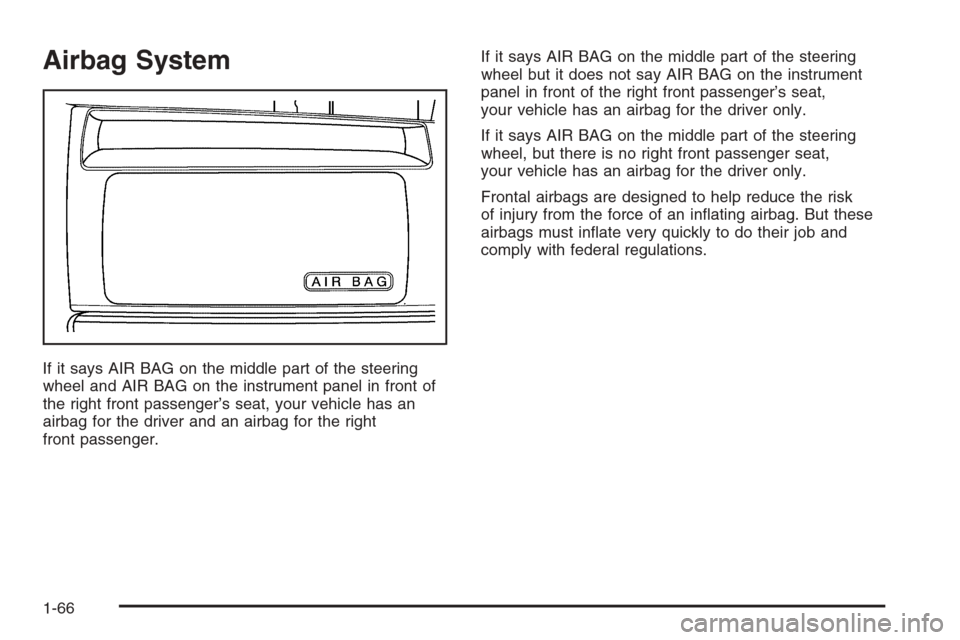
Airbag System
If it says AIR BAG on the middle part of the steering
wheel and AIR BAG on the instrument panel in front of
the right front passenger’s seat, your vehicle has an
airbag for the driver and an airbag for the right
front passenger.If it says AIR BAG on the middle part of the steering
wheel but it does not say AIR BAG on the instrument
panel in front of the right front passenger’s seat,
your vehicle has an airbag for the driver only.
If it says AIR BAG on the middle part of the steering
wheel, but there is no right front passenger seat,
your vehicle has an airbag for the driver only.
Frontal airbags are designed to help reduce the risk
of injury from the force of an inflating airbag. But these
airbags must inflate very quickly to do their job and
comply with federal regulations.
1-66
Page 74 of 406
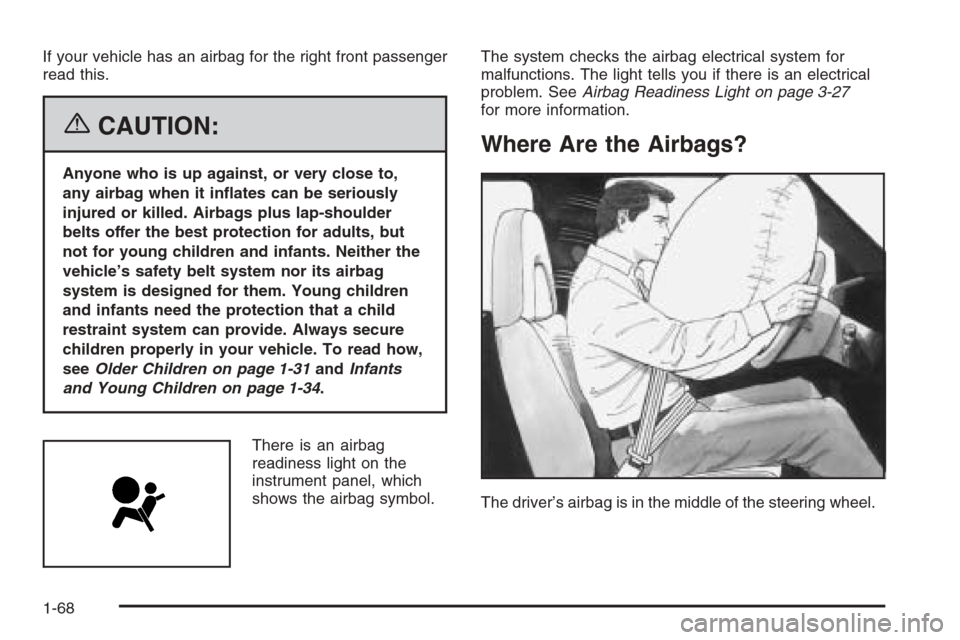
If your vehicle has an airbag for the right front passenger
read this.
{CAUTION:
Anyone who is up against, or very close to,
any airbag when it in�ates can be seriously
injured or killed. Airbags plus lap-shoulder
belts offer the best protection for adults, but
not for young children and infants. Neither the
vehicle’s safety belt system nor its airbag
system is designed for them. Young children
and infants need the protection that a child
restraint system can provide. Always secure
children properly in your vehicle. To read how,
seeOlder Children on page 1-31andInfants
and Young Children on page 1-34.
There is an airbag
readiness light on the
instrument panel, which
shows the airbag symbol.The system checks the airbag electrical system for
malfunctions. The light tells you if there is an electrical
problem. SeeAirbag Readiness Light on page 3-27
for more information.
Where Are the Airbags?
The driver’s airbag is in the middle of the steering wheel.
1-68
Page 75 of 406
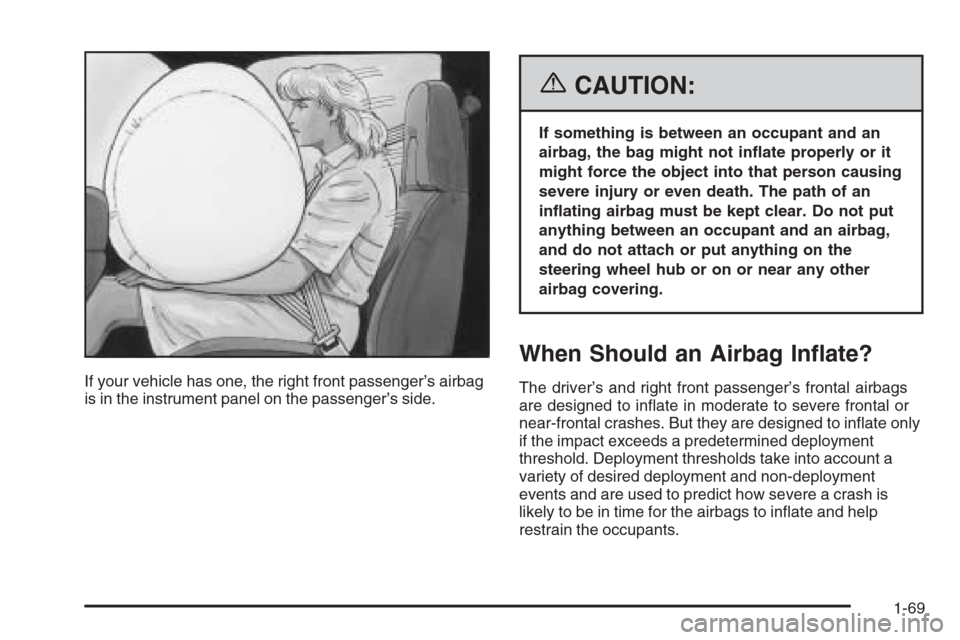
If your vehicle has one, the right front passenger’s airbag
is in the instrument panel on the passenger’s side.
{CAUTION:
If something is between an occupant and an
airbag, the bag might not in�ate properly or it
might force the object into that person causing
severe injury or even death. The path of an
in�ating airbag must be kept clear. Do not put
anything between an occupant and an airbag,
and do not attach or put anything on the
steering wheel hub or on or near any other
airbag covering.
When Should an Airbag In�ate?
The driver’s and right front passenger’s frontal airbags
are designed to inflate in moderate to severe frontal or
near-frontal crashes. But they are designed to inflate only
if the impact exceeds a predetermined deployment
threshold. Deployment thresholds take into account a
variety of desired deployment and non-deployment
events and are used to predict how severe a crash is
likely to be in time for the airbags to inflate and help
restrain the occupants.
1-69